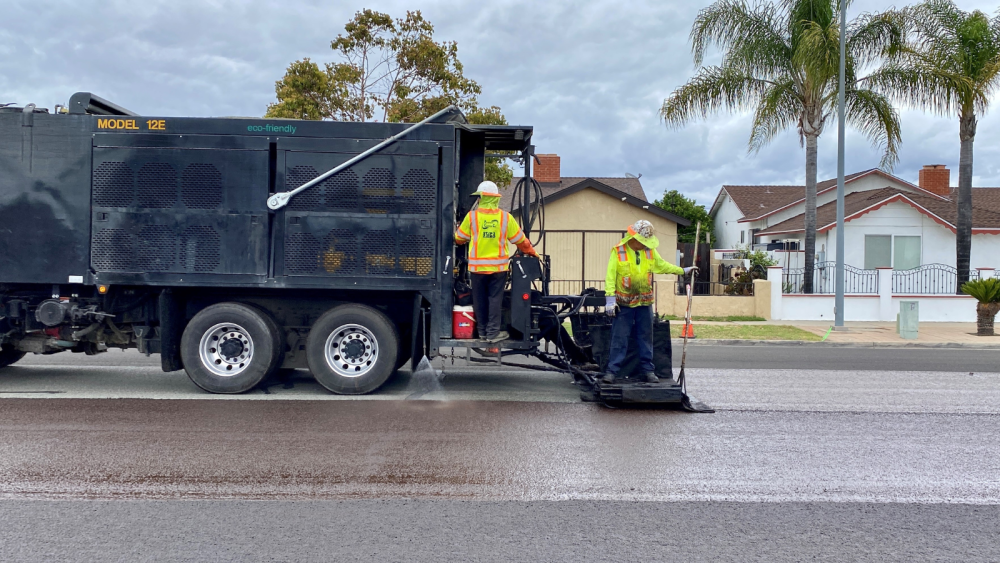Road Repair Projects Continue in Otay Mesa-Nestor, Navajo and Serra Mesa
June 13, 2024 | City News Team

Several City of San Diego communities will soon have improved and safer streets thanks to the continued efforts of the City’s slurry seal program, part of an overall effort to repair and resurface roads citywide. This week, the City will begin resurfacing streets in and around Otay Mesa-Nestor, Navajo and Serra Mesa.
Slurry seal is used to prevent the deterioration of streets, which is vital to improving the overall condition of San Diego’s network of roads. It reduces the need for a more costly asphalt overlay and reconstruction for badly deteriorated streets. Information about different types of street repair can be found on the Transportation webpage.
Slurry seal is often completed in phases over several days or weeks. Multiple slurry seal projects are happening across the City simultaneously and are often coupled with other facility updates to increase safety and mobility for all modes of transportation.
The latest work as part of Slurry and Cape Seal projects 2325, 2421 and 2422 will be completed, weather permitting, through the month of June. The following roads will be resurfaced:
- Athey Avenue
- Smythe Avenue
- Otay Mesa Road
- Siempre Viva Road
- Glacier Avenu
- Vandever Avenue
- Seaman Street
- Glenlea Lane
- Overlake Avenue
- Ridgemoor Drive
- Crystalaire Drive
- Rainswept Lane
- Suntree Place
- Morning Mist Court
- Crystal Lake Avenue
- Merced Lake Avenue
- Lake Decatur Avenue
- Lake Dora Avenue
- Badger Lake Avenue
- Gramercy Drive
- Beaver Lake Court
- Beaver Lake Drive
- Bisby Lake Drive
- June Lake Drive
- Budlong Lake Avenue
Slurry seal is a cost-effective pavement preservation method consisting of asphalt emulsion, sand and rock. This mixture is applied to the street surface at an average thickness of a quarter inch and extends the life of already in-good-condition streets.
Recently the City implemented two new street resurfacing methods – cape seal and scrub seal – which, similar to slurry seal, extend the life of roads by filling cracks, protecting against moisture incursion and minimizing the development of potholes and other surface deformities. The Transportation Department currently has multiple cape seal projects ongoing in several neighborhoods.
Streets are selected for resurfacing through a pavement management system that helps determine when to schedule streets and which type of repair is appropriate. Each street segment is assigned a Pavement Condition Index (PCI) score based on the pavement’s roughness and cracks.
To prioritize street paving, the PCI is used in conjunction with other factors, such as traffic volume, road type, equity, climate resiliency, mobility, maintenance history, other construction projects, and available funding. Repairs are often grouped within a neighborhood to include streets in similar conditions or performed after other projects, such as pipeline replacement.
View a map of past, current and future street repair in your neighborhood by visiting the City’s interactive StreetsSD map.
Filter by Category
Airports (1)
Arts and Culture (9)
Business (20)
Environment (44)
Human Interest (7)
Library (14)
Parks and Recreation (19)
Personnel (10)
Public Safety (19)
Public Works (57)
Technology (4)
Transportation (1)
Airports (1)
Arts and Culture (9)
Business (20)
Environment (44)
Human Interest (7)
Library (14)
Parks and Recreation (19)
Personnel (10)
Public Safety (19)
Public Works (57)
Technology (4)
Transportation (1)
